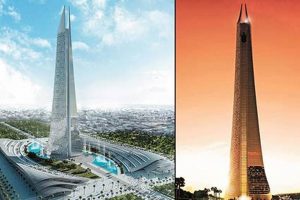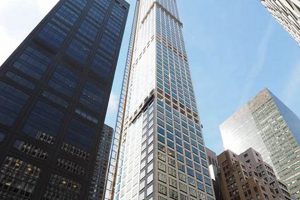A skyscraper is a continuously habitable high-rise building having multiple floors and a height noticeably greater than the height of an ordinary building. Most skyscrapers serve a commercial purpose, acting as office buildings, while others are residential. The term skyscraper is generally applied to buildings taller than 150 meters (492 feet).[1]
Skyscrapers have shaped the development of modern cities around the world, and have become popular for reasons such as high land prices in urban areas and the desire for more usable floor area. They have also become symbols of economic prosperity and architectural achievement.
The construction of skyscrapers has been made possible by advances in structural engineering and building materials. Early skyscrapers were built using steel frames, but today concrete is the most widely used material for skyscraper construction.
1. Tall
The term “tall” is often used to describe skyscrapers, and for good reason. Skyscrapers are some of the tallest structures in the world, with many standing over 1,000 feet tall. But what exactly does it mean for a building to be tall? And why is height such an important factor in the definition of a skyscraper?
There is no universally accepted definition of what constitutes a tall building, but most experts agree that a building must be at least 150 meters (492 feet) tall to be considered a skyscraper. This height requirement is based on a number of factors, including the need for a building to be structurally sound, the need to provide adequate fire safety measures, and the need to provide a reasonable level of comfort for occupants.
The height of a skyscraper can have a significant impact on its design and construction. Taller buildings require more robust structural systems to withstand wind loads and seismic forces. They also require more complex fire safety systems to ensure that occupants can evacuate safely in the event of a fire. And they require more sophisticated mechanical systems to provide adequate ventilation, heating, and cooling.
Despite the challenges involved in designing and constructing tall buildings, there are a number of reasons why developers continue to build them. Skyscrapers can provide a number of benefits, including:
- Increased density: Skyscrapers can accommodate more people and businesses in a smaller area, which can help to reduce urban sprawl.
- Improved energy efficiency: Skyscrapers can be designed to be more energy efficient than smaller buildings, thanks to their ability to take advantage of natural ventilation and daylighting.
- Enhanced prestige: Skyscrapers can be seen as symbols of economic prosperity and architectural achievement, which can make them attractive to businesses and investors.
Skyscrapers are a major part of the urban landscape, and they continue to play an important role in the development of cities around the world.
2. High-rise
The term “high-rise” is often used interchangeably with “skyscraper,” but there is actually a subtle distinction between the two terms. A high-rise building is any building that is taller than the surrounding buildings, while a skyscraper is a high-rise building that is particularly tall and distinctive. In general, a building must be at least 150 meters (492 feet) tall to be considered a skyscraper.
High-rise buildings are often used for commercial purposes, such as office space, retail space, and hotels. However, they can also be used for residential purposes. High-rise buildings are becoming increasingly popular in urban areas, as they can help to reduce sprawl and provide more affordable housing options.
There are a number of challenges associated with the construction of high-rise buildings. These challenges include:
- Structural engineering: High-rise buildings must be designed to withstand wind loads and seismic forces. This requires the use of specialized structural engineering techniques.
- Fire safety: High-rise buildings must be designed to provide adequate fire safety measures. This includes the use of fire-resistant materials, fire sprinklers, and smoke detectors.
- Mechanical systems: High-rise buildings require complex mechanical systems to provide adequate ventilation, heating, and cooling. These systems must be designed to be energy efficient and reliable.
Despite the challenges, high-rise buildings offer a number of benefits. These benefits include:
- Increased density: High-rise buildings can accommodate more people and businesses in a smaller area, which can help to reduce urban sprawl.
- Improved energy efficiency: High-rise buildings can be designed to be more energy efficient than smaller buildings, thanks to their ability to take advantage of natural ventilation and daylighting.
- Enhanced prestige: High-rise buildings can be seen as symbols of economic prosperity and architectural achievement, which can make them attractive to businesses and investors.
High-rise buildings are a major part of the urban landscape, and they continue to play an important role in the development of cities around the world.
3. Multi-story
A skyscraper is a continuously habitable high-rise building having multiple floors and a height noticeably greater than the height of an ordinary building. The term “multi-story” is used to describe buildings that have more than one story, or level. Skyscrapers are almost always multi-story buildings, with some having over 100 stories. The Burj Khalifa, the tallest building in the world, has 163 stories.
There are a number of reasons why skyscrapers are typically multi-story buildings. First, multi-story buildings allow for more efficient use of land. By building up, rather than out, skyscrapers can accommodate more people and businesses in a smaller area. This is especially important in urban areas, where land is scarce and expensive.
Second, multi-story buildings can be more energy efficient than single-story buildings. This is because multi-story buildings can take advantage of natural ventilation and daylighting. This can reduce the need for artificial lighting and heating, which can save energy and money.
Third, multi-story buildings can be more prestigious than single-story buildings. This is because multi-story buildings are often seen as symbols of economic prosperity and architectural achievement. This can make them attractive to businesses and investors.
The construction of multi-story buildings presents a number of challenges. These challenges include:
- Structural engineering: Multi-story buildings must be designed to withstand wind loads and seismic forces. This requires the use of
specialized structural engineering techniques. - Fire safety: Multi-story buildings must be designed to provide adequate fire safety measures. This includes the use of fire-resistant materials, fire sprinklers, and smoke detectors.
- Mechanical systems: Multi-story buildings require complex mechanical systems to provide adequate ventilation, heating, and cooling. These systems must be designed to be energy efficient and reliable.
Despite the challenges, multi-story buildings offer a number of benefits. These benefits include:
- Increased density: Multi-story buildings can accommodate more people and businesses in a smaller area, which can help to reduce urban sprawl.
- Improved energy efficiency: Multi-story buildings can be designed to be more energy efficient than single-story buildings, thanks to their ability to take advantage of natural ventilation and daylighting.
- Enhanced prestige: Multi-story buildings can be seen as symbols of economic prosperity and architectural achievement, which can make them attractive to businesses and investors.
Multi-story buildings are a major part of the urban landscape, and they continue to play an important role in the development of cities around the world.
4. Commercial
Skyscrapers are predominantly commercial buildings, housing offices, retail spaces, and other businesses. This connection is deeply rooted in several key factors:
- Vertical Space Utilization
In densely populated urban areas, land for construction is scarce and expensive. Skyscrapers, with their towering heights, offer a solution by maximizing vertical space utilization. They can accommodate a large number of businesses and employees within a relatively small footprint, making them an efficient use of valuable land. - Centralized Business Hubs
Skyscrapers often serve as central hubs for businesses, attracting companies from various industries. This concentration of commercial activities creates a vibrant ecosystem where businesses can collaborate, network, and access shared resources. The proximity to other businesses and potential clients makes skyscrapers desirable locations for companies seeking growth opportunities. - Prestige and Status
Skyscrapers, with their impressive heights and architectural grandeur, are often seen as symbols of economic power and success. Occupying office space in a skyscraper can enhance a company’s image, attract top talent, and convey a sense of prestige and stability to clients and partners. - Accessibility and Transportation
Skyscrapers are typically located in central business districts or well-connected transportation hubs. This accessibility makes it convenient for employees, clients, and visitors to commute to and from the building. The proximity to public transportation, highways, and airports further enhances the commercial viability of skyscrapers.
In summary, the commercial nature of skyscrapers is driven by their efficient use of space, their role as central business hubs, the prestige and status they convey, and their accessibility. These factors make skyscrapers attractive to businesses seeking to establish a strong presence in urban centers and contribute to the economic growth and development of cities.
5. Residential
Skyscrapers, while predominantly associated with commercial purposes, also have a significant residential component. Residential skyscrapers, also known as apartment towers or condo buildings, have become increasingly popular in urban areas, offering a unique blend of luxury, convenience, and breathtaking views.
Several factors contribute to the growing demand for residential skyscrapers:
- Urbanization and Population Growth: As cities expand and populations grow, the demand for housing increases. Skyscrapers provide a viable solution by maximizing vertical space utilization, allowing for a high density of residential units within a limited footprint.
- Lifestyle Preferences: Residential skyscrapers offer a modern and luxurious lifestyle, attracting individuals and families seeking amenities such as rooftop terraces, fitness centers, and concierge services. The convenience of having residential units within close proximity to commercial hubs, entertainment venues, and public transportation further enhances their appeal.
- Investment Opportunities: Residential skyscrapers represent attractive investment opportunities for both individuals and real estate developers. The scarcity of land in urban areas and the increasing demand for housing make investing in residential skyscrapers a potentially lucrative endeavor.
Residential skyscrapers not only provide housing but also contribute to the vibrancy and diversity of urban environments. They create mixed-use developments, where residents can live, work, and enjoy amenities within the same neighborhood. This integration promotes walkability, reduces traffic congestion, and fosters a sense of community.
However, the construction and management of residential skyscrapers come with certain challenges. These include ensuring adequate fire safety measures, addressing noise and privacy concerns, and providing efficient waste management systems. Overcoming these challenges requires careful planning, advanced building technologies, and ongoing maintenance efforts.
In conclusion, residential skyscrapers represent a significant aspect of the definition of skyscrapers, catering to the growing demand for urban housing and offering a unique lifestyle experience. As cities continue to evolve, residential skyscrapers are likely to play an increasingly important role in shaping the urban landscape.
6. Urban
The term “urban” is closely intertwined with the definition of a skyscraper. Skyscrapers are predominantly urban structures, towering over the surrounding cityscape and shaping the architectural landscape of cities around the world.
- High Population Density
Urban areas are characterized by high population densities, making efficient land use a necessity. Skyscrapers provide a solution by maximizing vertical space utilization, allowing for a large number of people to live and work within a relatively small footprint.
- Centralized Business Districts
Skyscrapers are often concentrated in central business districts (CBDs), where commercial activities are younlamtr. This proximity to businesses, financial institutions, and transportation hubs makes skyscrapers attractive to companies and professionals seeking to be in the heart of the urban economy.
- Public Transportation and Accessibility
Skyscrapers are typically located near public transportation networks, making them easily accessible to residents, workers, and visitors. This connectivity enables efficient movement within the city and reduces reliance on personal vehicles.
- Mixed-Use Developments
Modern skyscrapers often incorporate mixed-use developments, combining residential, commercial, and retail spaces withi
n the same building. This integration creates vibrant and self-contained urban environments where people can live, work, and enjoy amenities without the need for extensive travel.
In summary, the “urban” aspect of skyscrapers encompasses their role in accommodating high population densities, their presence in central business districts, their accessibility through public transportation, and their contribution to mixed-use developments. These factors collectively define the symbiotic relationship between skyscrapers and the urban environment.
7. Landmark
Skyscrapers, with their towering heights and architectural grandeur, often become iconic landmarks that define the skylines of cities. The connection between “landmark” and “definition of skyscraper” is deeply rooted in several key factors:
- Architectural Significance: Skyscrapers push the boundaries of architectural design and innovation, showcasing unique and groundbreaking structural forms. Their distinct silhouettes and innovative facades make them instantly recognizable, transforming them into architectural landmarks that symbolize the city’s identity and architectural prowess.
- Historical Importance: Many skyscrapers are associated with significant historical events or periods. They serve as tangible reminders of the city’s past and its architectural heritage. Preserving and recognizing these skyscrapers as landmarks ensures their protection and appreciation for future generations.
- Cultural Symbolism: Skyscrapers often embody the cultural and economic aspirations of a city. They represent progress, ambition, and prosperity, becoming symbols of pride and identity for the local community. Their landmark status reinforces their cultural significance and strengthens their connection to the city’s narrative.
- Tourist Attractions: Landmark skyscrapers attract tourists from around the world, eager to witness their architectural marvels and experience the stunning views they offer. Their iconic status makes them must-see destinations, contributing to the city’s tourism industry and economic growth.
The practical significance of understanding the connection between “landmark” and “definition of skyscraper” lies in recognizing and preserving these architectural treasures. By designating skyscrapers as landmarks, cities can ensure their protection from demolition or alteration, safeguarding their historical, cultural, and architectural value. Additionally, it promotes sustainable urban development by encouraging the adaptive reuse of historic skyscrapers, contributing to the city’s architectural diversity and character.
In conclusion, the connection between “landmark” and “definition of skyscraper” underscores the importance of skyscrapers as architectural and cultural icons that shape the identity of cities. Their landmark status recognizes their architectural significance, historical importance, cultural symbolism, and tourist appeal. Preserving and celebrating these landmark skyscrapers ensures their enduring presence as symbols of urban progress, innovation, and heritage.
FAQs on the Definition of Skyscraper
This section provides answers to frequently asked questions about skyscrapers, exploring various aspects of their definition, significance, and impact.
Question 1: What is the defining characteristic of a skyscraper?
A skyscraper is a continuously habitable high-rise building with multiple floors and a height significantly greater than that of ordinary buildings. The Council on Tall Buildings and Urban Habitat (CTBUH) defines a skyscraper as a building with a height of at least 150 meters (492 feet).
Question 2: What is the purpose of skyscrapers?
Skyscrapers serve various purposes, primarily commercial and residential. Commercial skyscrapers house offices, retail spaces, and other businesses, while residential skyscrapers offer housing units, often with luxury amenities and stunning views. Some skyscrapers also incorporate mixed-use developments, combining residential, commercial, and retail spaces within the same building.
Question 3: Why are skyscrapers concentrated in urban areas?
Skyscrapers are predominantly located in urban areas due to several reasons. Firstly, urban areas have high population densities, making efficient land use crucial. Skyscrapers allow for a large number of people to live and work within a relatively small footprint. Secondly, cities are economic centers, attracting businesses and professionals seeking proximity to commercial hubs and transportation networks.
Question 4: What are the benefits of skyscrapers?
Skyscrapers offer numerous benefits. They promote efficient land use, reduce urban sprawl, and provide businesses with a concentrated and accessible location. Skyscrapers can also enhance energy efficiency by taking advantage of natural ventilation and daylighting. Additionally, they serve as landmarks, symbolizing economic prosperity and architectural achievement.
Question 5: What are the challenges in constructing skyscrapers?
Constructing skyscrapers presents several challenges. Firstly, they require specialized structural engineering to withstand wind loads and seismic forces. Secondly, fire safety measures are paramount, necessitating the use of fire-resistant materials and advanced fire suppression systems. Thirdly, complex mechanical systems are needed to provide efficient ventilation, heating, and cooling throughout the building.
Question 6: What is the future of skyscrapers?
The future of skyscrapers is promising, with ongoing advancements in architectural design, engineering techniques, and sustainable building practices. We can expect innovative skyscrapers that push the boundaries of height and design, incorporate smart technologies, and prioritize sustainability. Skyscrapers will continue to play a significant role in shaping the skylines and economies of major cities around the world.
Summary: Skyscrapers are defined by their exceptional height and are primarily used for commercial and residential purposes. Concentrated in urban areas, they offer benefits such as efficient land use and enhanced energy efficiency. Constructing skyscrapers involves challenges in structural engineering, fire safety, and mechanical systems. The future of skyscrapers is characterized by advancements in design, engineering, and sustainability, promising continued innovation and impact on the urban landscape.
Transition to Next Section: This concludes our exploration of the definition of skyscrapers and related FAQs. In the next section, we will delve into the history and evolution of skyscrapers, examining their architectural significance and impact on urban environments.
Tips on Understanding the Definition of Skyscraper
Understanding the definition of a skyscraper involves considering its key characteristics, purposes, and impact on the urban environment. Here are some tips to enhance your comprehension:
Tip 1: Focus on Height and Structure
A skyscraper is distinguished by its exceptional height, typically exceeding 150 meters (492 feet). Its structure is designed to withstand wind loads and seismic forces, making it a continuous and habitable high-rise building.
Tip 2: Recognize Commercial and Residential Purposes
Skyscrapers primarily serve commercial purposes, housing offices, retail spaces, and businesses. They also play a significant role in residenti
al living, offering luxury apartments and condominiums with stunning views. Some skyscrapers incorporate mixed-use developments, combining commercial and residential spaces.
Tip 3: Understand Urban Significance
Skyscrapers are predominantly located in urban areas due to high population densities and centralized business districts. They promote efficient land use, reduce urban sprawl, and provide accessibility to transportation hubs.
Tip 4: Consider Architectural Impact
Skyscrapers often become iconic landmarks, shaping the skylines of cities. Their architectural designs showcase innovation and push the boundaries of engineering. They serve as symbols of economic prosperity and cultural identity.
Tip 5: Analyze Construction Challenges
Constructing skyscrapers involves specialized structural engineering to ensure stability. Fire safety measures, such as fire-resistant materials and advanced suppression systems, are crucial. Additionally, complex mechanical systems are needed to provide efficient ventilation, heating, and cooling throughout the building.
Summary: By considering these tips, you can develop a comprehensive understanding of the definition of a skyscraper and its significance in the urban environment.
Transition to Conclusion: Understanding the definition of a skyscraper is essential for appreciating its role in shaping modern cities. In the concluding section, we will explore the historical evolution of skyscrapers and their continued impact on architecture and urban development.
Conclusion
In conclusion, the definition of a skyscraper encompasses its exceptional height, continuous habitability, and significance in the urban environment. Skyscrapers serve diverse purposes, ranging from commercial offices to residential apartments, and have become iconic landmarks that shape city skylines. Their construction involves specialized engineering and architectural innovation to ensure structural stability, fire safety, and efficient mechanical systems.
Skyscrapers represent the ingenuity and ambition of human endeavor, pushing the boundaries of design and construction. They embody the economic prosperity and cultural aspirations of cities, becoming symbols of progress and modernity. As cities continue to grow and evolve, skyscrapers will undoubtedly remain a defining feature of urban landscapes, inspiring awe and serving as testaments to architectural prowess.







